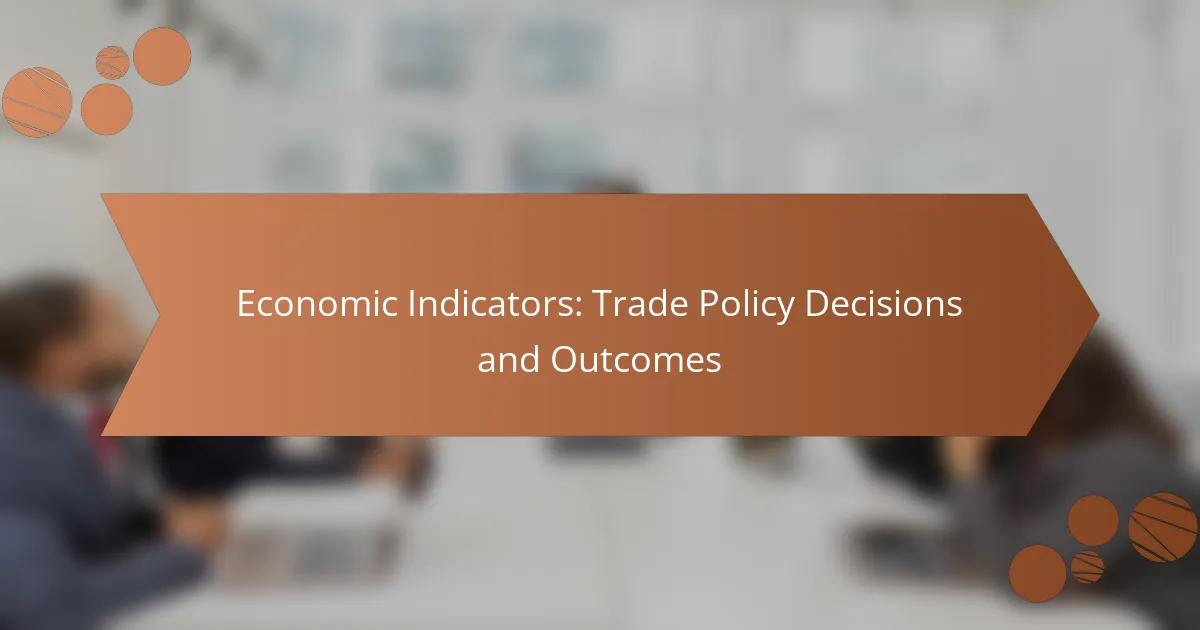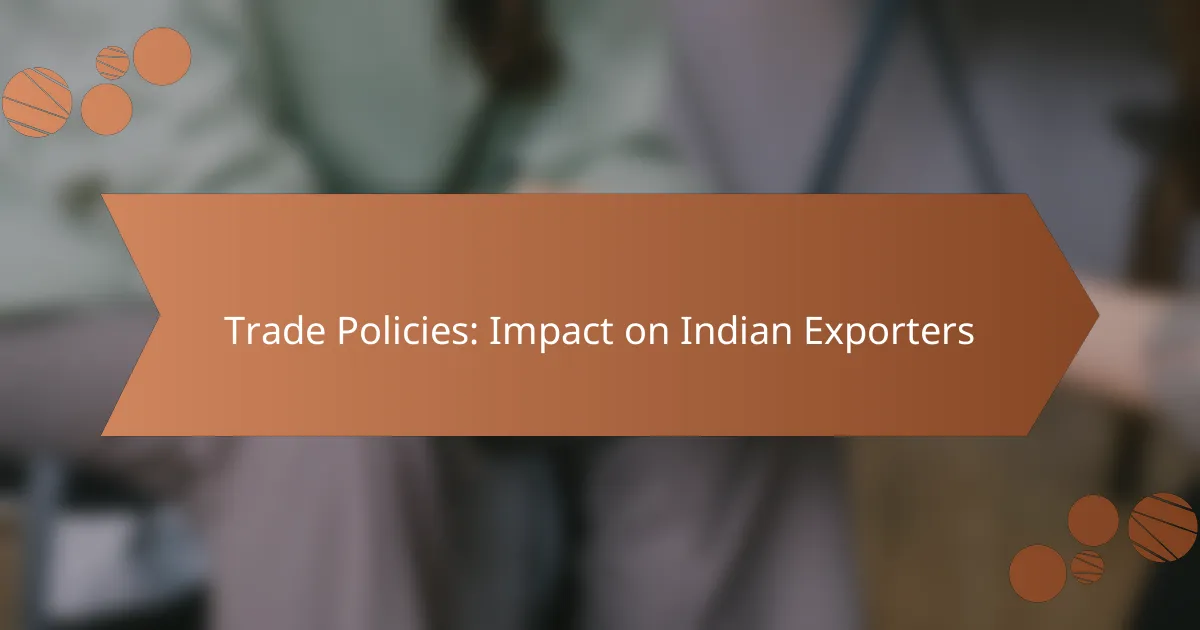Tariffs play a crucial role in shaping consumer prices in the United States by increasing the cost of imported goods, which ultimately leads to higher retail prices and contributes to inflation. As businesses often pass these added costs onto consumers, the impact is felt across a wide range of everyday products. Additionally, various types of tariffs, including import tariffs and trade duties, significantly influence market dynamics, particularly in the e-commerce sector, affecting pricing and product availability.
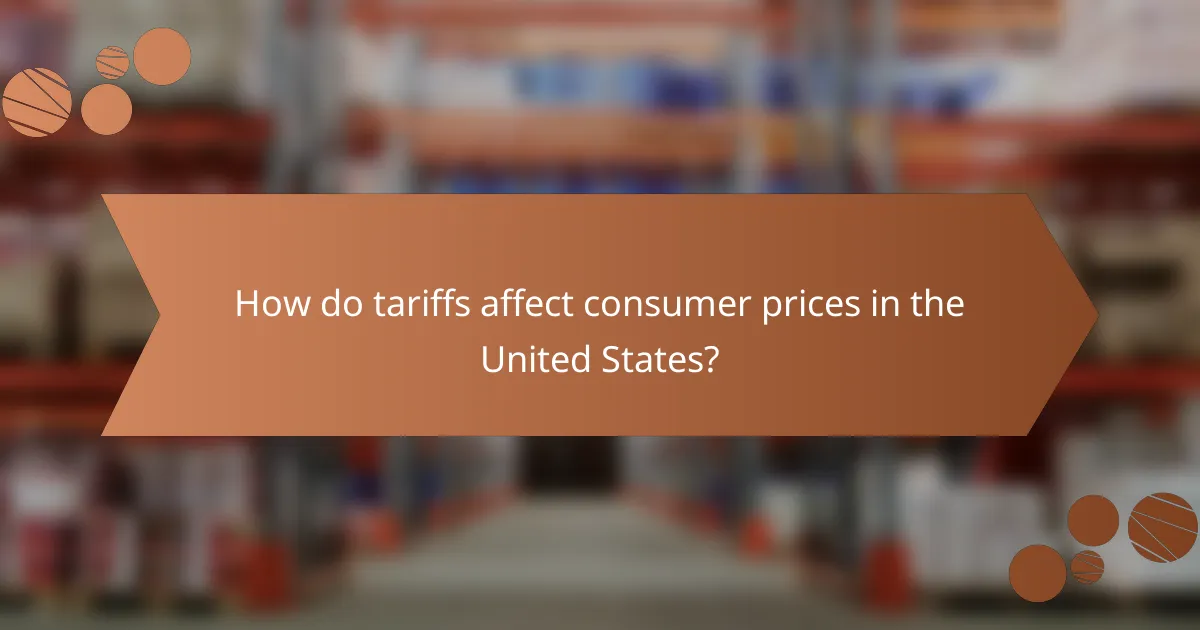
How do tariffs affect consumer prices in the United States?
Tariffs increase consumer prices in the United States by raising the cost of imported goods, which in turn affects retail pricing and overall inflation. When tariffs are imposed, businesses often pass these costs onto consumers, leading to higher prices for everyday products.
Increased costs for imported goods
Tariffs directly raise the cost of imported goods, as businesses must pay additional taxes on these products. For example, if a tariff of 25% is placed on steel, the price of steel imports rises significantly, affecting industries that rely on this material.
As a result, companies may seek alternative suppliers or materials, but these changes can take time and may not fully offset the increased costs. Consumers may notice higher prices on products that use imported steel, such as cars and appliances.
Higher retail prices for consumers
When businesses face increased costs due to tariffs, they often pass these expenses onto consumers in the form of higher retail prices. This can lead to noticeable price increases on a variety of goods, from electronics to clothing.
For instance, if a popular smartphone model relies on imported components subject to tariffs, the retail price may rise by a significant percentage. Consumers should be prepared for these price adjustments, which can vary widely depending on the product and the extent of the tariffs imposed.
Impact on inflation rates
Tariffs can contribute to rising inflation rates as increased consumer prices become a part of the overall cost of living. When many goods see price hikes, it can lead to a general increase in the Consumer Price Index (CPI), which measures inflation.
In the U.S., even a modest increase in tariffs can lead to inflationary pressures, affecting purchasing power. Consumers may find that their money does not stretch as far, prompting a reevaluation of spending habits and priorities.
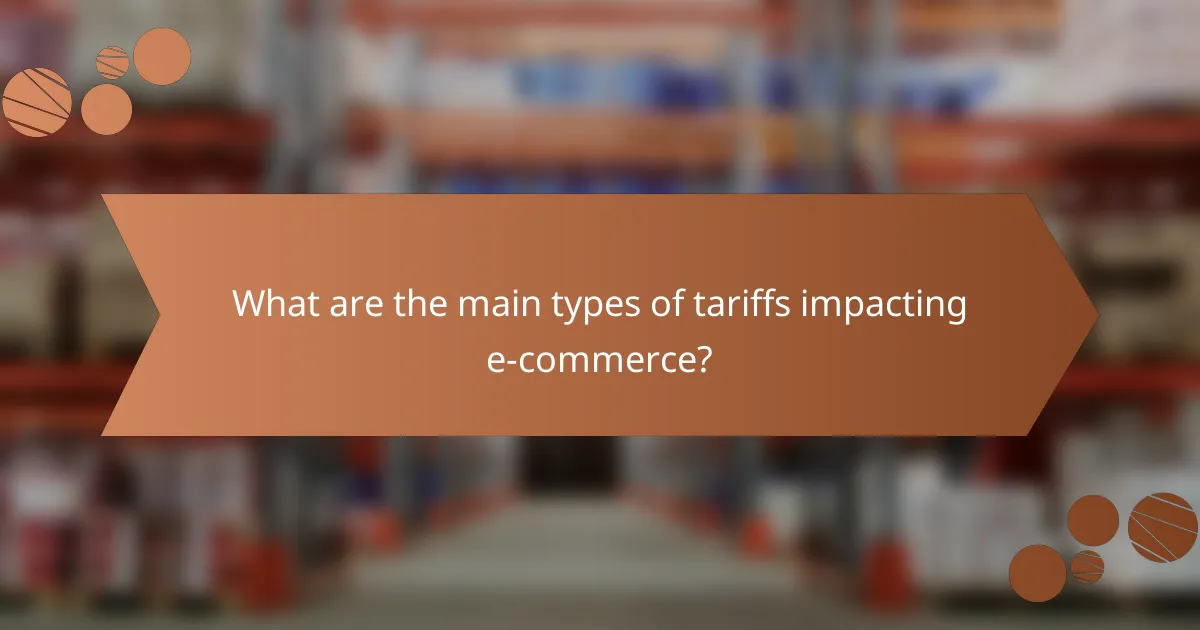
What are the main types of tariffs impacting e-commerce?
The main types of tariffs impacting e-commerce include import tariffs, trade duties, and specific tariffs on various goods. These tariffs can significantly affect pricing, availability, and market dynamics for online retailers and consumers alike.
Import tariffs on electronics
Import tariffs on electronics are taxes imposed on electronic goods brought into a country. These tariffs can range from low single digits to over 20% depending on the product and the country of origin.
For example, a smartphone imported into the United States might incur a tariff of around 10%, which can lead to higher retail prices for consumers. E-commerce businesses must factor these costs into their pricing strategies to remain competitive.
Tariffs on textiles and apparel
Tariffs on textiles and apparel are common in international trade, often aimed at protecting domestic industries. These tariffs can vary widely, typically ranging from 5% to 30% based on the type of fabric and finished product.
For instance, importing clothing from Asia to Europe may attract a tariff of about 12%. E-commerce retailers should be aware of these tariffs when sourcing products, as they can significantly impact profit margins and pricing structures.
Trade duties on agricultural products
Trade duties on agricultural products are tariffs applied to food items and raw agricultural goods. These duties can be particularly high, often exceeding 20%, to protect local farmers and producers.
For example, importing certain fruits or vegetables into the European Union may involve substantial tariffs. E-commerce platforms selling food items should consider these costs, as they can influence the final price consumers pay and the overall competitiveness of their offerings.
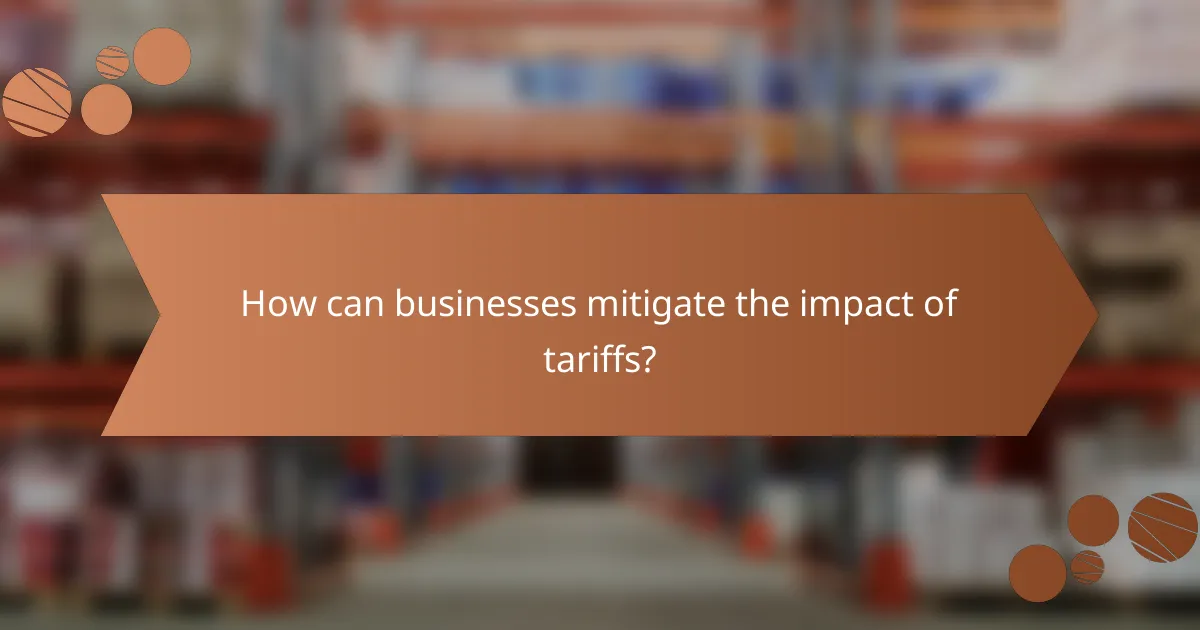
How can businesses mitigate the impact of tariffs?
Businesses can mitigate the impact of tariffs by adjusting their pricing strategies, diversifying supply chains, and exploring alternative markets. These approaches help maintain competitiveness and protect profit margins in the face of increased costs due to tariffs.
Adjusting pricing strategies
One effective way to mitigate tariff impacts is by adjusting pricing strategies. Businesses can consider raising prices slightly to offset increased costs, but they must balance this with customer sensitivity to price changes. Implementing tiered pricing or offering discounts on bulk purchases can also help maintain sales volume.
Another option is to enhance value perception through marketing, emphasizing quality or unique features to justify higher prices. Regularly reviewing pricing in response to tariff changes ensures that businesses remain competitive while protecting their margins.
Diversifying supply chains
Diversifying supply chains is crucial for reducing dependency on any single source affected by tariffs. Businesses should evaluate their suppliers and consider sourcing materials or products from countries with lower or no tariffs. This strategy not only mitigates costs but also enhances resilience against supply disruptions.
Establishing relationships with multiple suppliers can provide flexibility and bargaining power. Companies should also assess the total landed cost, including shipping and tariffs, to make informed sourcing decisions that optimize their supply chain efficiency.
Exploring alternative markets
Exploring alternative markets can help businesses offset the impact of tariffs by tapping into new customer bases. Companies should identify regions or countries where their products are in demand and tariffs are lower or non-existent. This approach can lead to increased sales and reduced reliance on domestic markets.
Conducting market research to understand local consumer preferences and regulations is essential. Businesses should also consider adapting their products or marketing strategies to fit the cultural context of new markets, ensuring a smoother entry and better acceptance among consumers.
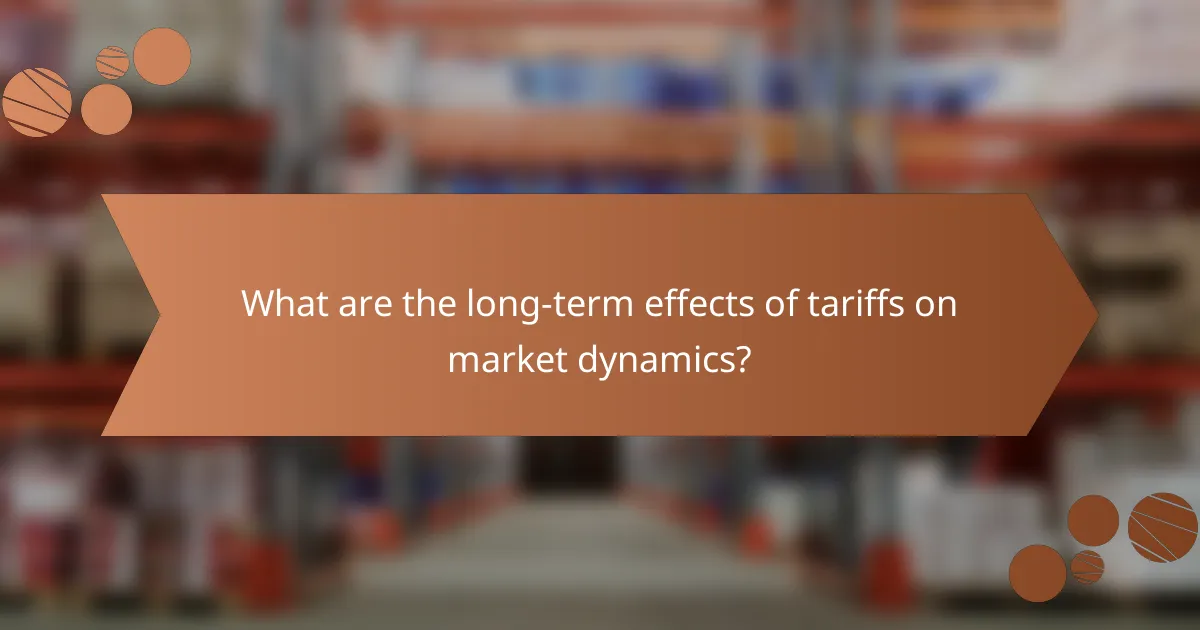
What are the long-term effects of tariffs on market dynamics?
Long-term tariffs can significantly alter market dynamics by affecting pricing, supply chains, and consumer choices. They often lead to increased costs for imported goods, which can shift purchasing behaviors and reshape competitive landscapes.
Shifts in consumer behavior
Tariffs typically result in higher prices for imported products, prompting consumers to reassess their purchasing decisions. For instance, if tariffs raise the cost of foreign electronics, buyers may turn to domestic alternatives or delay purchases altogether.
Additionally, consumers may seek out substitutes or lower-cost options, which can lead to a decline in demand for certain imported goods. This shift can create opportunities for local businesses to fill the gap left by reduced imports.
Changes in competitive landscape
The imposition of tariffs can alter the competitive dynamics within industries by protecting domestic producers from foreign competition. This protection can lead to increased market share for local companies, allowing them to raise prices without losing customers.
However, over time, this can also result in complacency among domestic firms, as they may not feel pressured to innovate or improve efficiency. Consumers may ultimately face fewer choices and higher prices if domestic companies do not respond effectively to changing market demands.
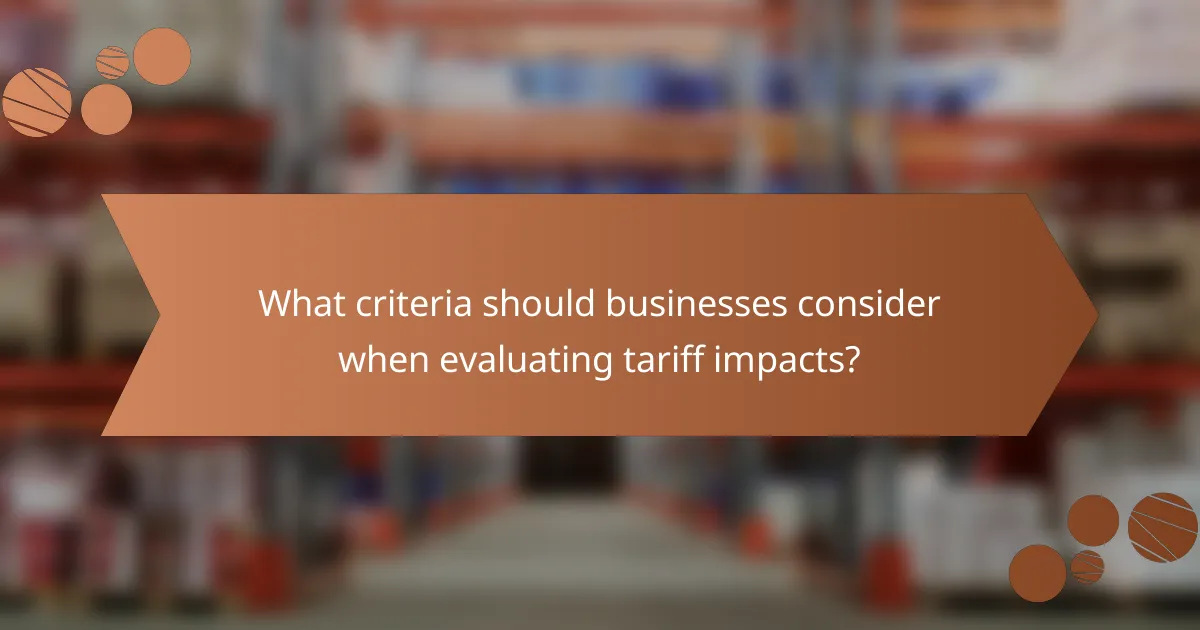
What criteria should businesses consider when evaluating tariff impacts?
Businesses should assess how tariffs affect their cost structures, pricing strategies, and overall market competitiveness. Key considerations include the direct cost of tariffs, potential changes in consumer demand, and the competitive landscape influenced by these tariffs.
Cost-benefit analysis of tariffs
A cost-benefit analysis of tariffs involves comparing the additional costs imposed by tariffs against potential benefits, such as increased domestic production. Businesses should calculate the total tariff costs and evaluate how these might impact pricing and profit margins.
For example, if a company imports goods worth $100,000 and faces a 10% tariff, the additional cost is $10,000. If this leads to a price increase that reduces sales by 5%, the business must weigh these losses against the benefits of supporting local suppliers or maintaining market share.
Market demand fluctuations
Tariffs can lead to significant fluctuations in market demand, as consumers may react to increased prices by altering their purchasing behavior. Understanding how price sensitivity affects demand is crucial for businesses navigating tariff impacts.
For instance, if a tariff raises the price of imported electronics by 15%, consumers might shift to cheaper alternatives, impacting sales volumes. Businesses should monitor consumer trends and adjust marketing strategies accordingly to maintain demand amidst changing price points.
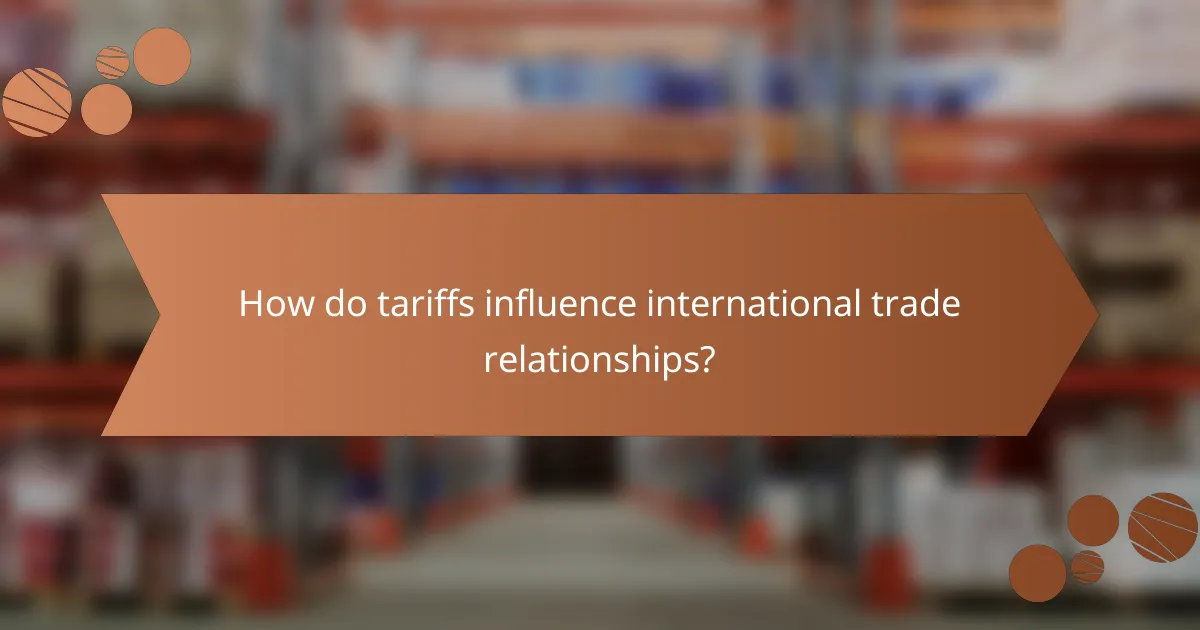
How do tariffs influence international trade relationships?
Tariffs significantly affect international trade relationships by altering the cost structure of imported goods. When a country imposes tariffs, it raises the price of foreign products, which can lead to reduced imports and changes in trade dynamics.
Effects on consumer prices
Tariffs typically lead to higher consumer prices for imported goods. When tariffs are applied, businesses often pass on the increased costs to consumers, resulting in higher retail prices. For example, a 10% tariff on electronics could raise prices by a similar percentage, making these products less affordable.
Consumers may also find fewer choices in the market as some foreign products become too expensive to import. This reduction in competition can further drive up prices for domestic alternatives, impacting overall market dynamics.
Impact on domestic industries
While tariffs can protect domestic industries from foreign competition, they can also lead to inefficiencies. Companies may become reliant on tariff protection and lack the incentive to innovate or improve efficiency. This can result in stagnation within the protected industries.
In some cases, tariffs can lead to retaliatory measures from other countries, which may harm domestic exporters. For instance, if a country imposes tariffs on steel imports, the affected countries might respond with tariffs on agricultural products, impacting farmers and producers.
Long-term trade relationships
Over time, tariffs can strain international trade relationships. Countries affected by tariffs may seek to establish new trade agreements or partnerships, leading to a shift in global trade alliances. This can create instability in markets and affect long-term economic growth.
Maintaining open communication and negotiation can help mitigate the negative impacts of tariffs. Countries that engage in dialogue may find ways to reduce tariffs or establish mutually beneficial agreements that foster better trade relationships.


